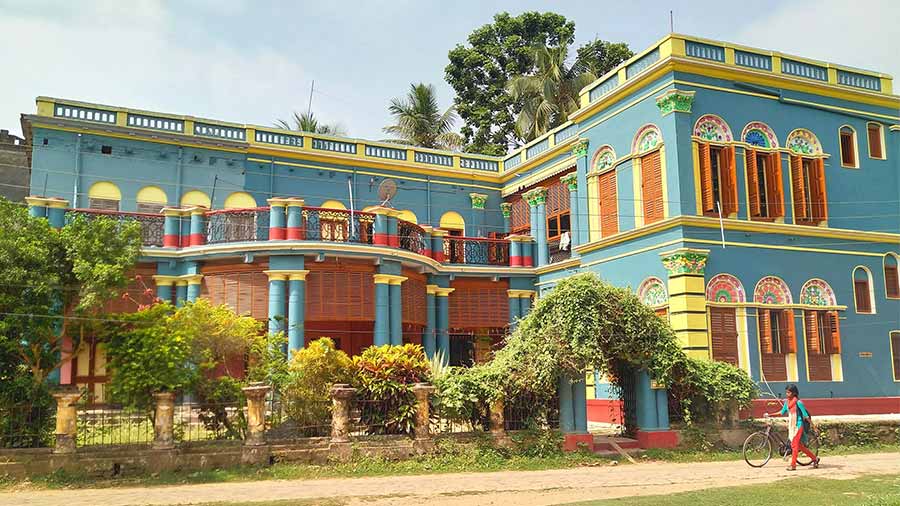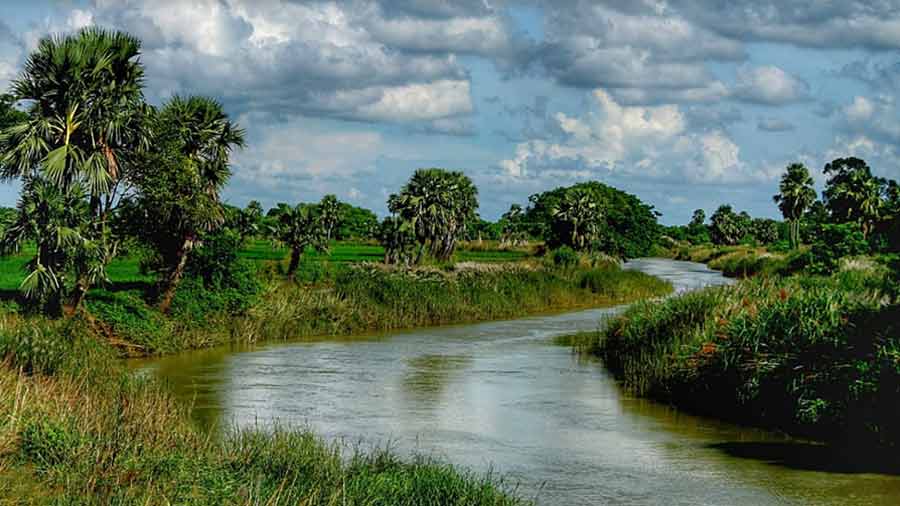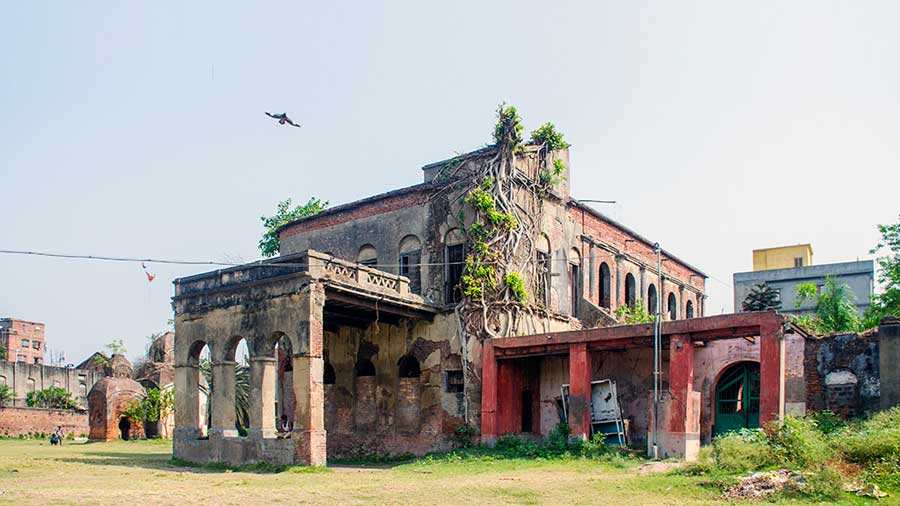If you enjoy walking tours, and heritage tours in the countryside, then a walk through the lanes of these quaint, scenic Bengal villages will be a welcome holiday for you. This cluster of villages in the Amta block of Howrah district date back to British times when Amta developed into a town connected by rain and waterway.
The Howrah-Amta narrow gauge line opened up Domjur and Amta in the late 1890s, while the Amta Bandar (jetty) on the Damodar brought small ships and boats to the town.
Since Amta was a prominent town in Howrah district, there was no dearth of temples and sprawling mansions belonging to the affluent in the neighbouring villages. In fact, the Melaichandi temple in Amta town, built in 1649, is a prominent Satipith in India.
A tour of the villages can be comfortably covered in a day, making this a perfect day trip from Kolkata.
Rautara
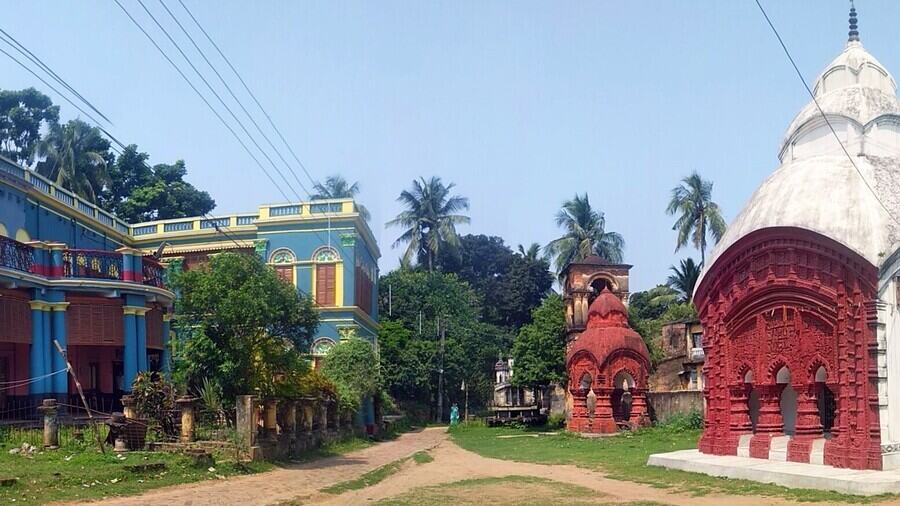
Roy Mansion and Damodar Jiu temple with Dol Mancha at Rautara
Jhikira and Rautara are neighbouring settlements about 13km from Amta railway station. Several clusters of samadhi mandirs, or memorial temples, built in the name of the deceased, greet visitors along the entry route to the villages.
Park your car at the petrol pump near Jhikira bus stand and walk through the narrow lanes of the village. An eastern-side road leading towards Rautara opens up to a vast area with many old mansions, along with terracotta-work structures including a brick temple, a Dol Mancha, a Nahabatkhana and a ruined Rasmancha.

Stucco work on the old mansions
The mansion of the Roy family, which was their residence, has seen some renovation and paint work unlike many of the others. Many of these have exquisite stucco work on their inner and outer walls.
The aatchala Damador Jiu temple, built in 1762, has been converted into a barochala (12-arched) temple during renovation. The temple’s arched panels depict scenes from the Ramayana, while at the base there are panels showcasing Krishna Lila scenes and images from daily life such as social gatherings, ships, chariots and hunting scenes. The Dol Mancha right beside it also has many terracotta panels that have remained in decent condition.
A wooden chariot stands next to these, which was constructed under the supervision of Ram Choudhury Roy in the year 1853. Though it was restored twice in the early and mid 1900s, the chariot is presently in a poor condition.
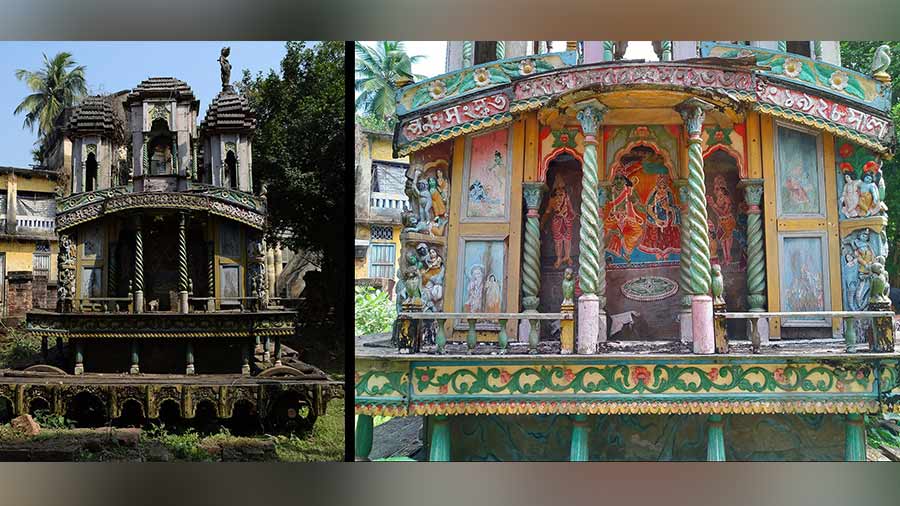
The wooden chariot
The mansions and the temples belong to the Roy family, who are old descendants of Rautara. According to descendant Arpan Roy, the family settled here after a skirmish with local hooligans and ultimately drove them away from the area. Several branches of the family have settled in different areas of Rautara and Jhikira.
At the end of this lane, three Shiva temples stand side by side — one aatchala and two built in the Deul style. It is said that the aatchala temple was built in 1926, in memory of Ananga Manjari Dasi, the wife of Jiban Krishna Roy, to whom the present lineage of the Rautara Roy family can be traced back.

A terracotta panel depicting a scene from the Ramayana
Another lane leading in the opposite direction from the main road takes you to an extension of Rautara village. The Kerani Bati, or clerk’s mansion, stands beside a pond along this road. The owners of the old mansion are related to the Roy family, and their ancestors were employed as clerks by the Bardhaman Maharajas. Inside, there is a nondescript aatchala temple, and a two-storied shrine for the family deity.

Sitaram Jiu temple
A stone’s throw away from Kerani Bati is the Sitaram Jiu temple of the Ghosh family, supposed to be the oldest temple of Rautara, which has some of the finest and rarest terracotta panels. Built in 1700, this aatchala temple also has scenes from the Ramayana on its panels, including rare scenes like Rama shooting Bali while he fought Sugriva. At the base are two rows of terracotta motifs similar to the ones of Damodar Jiu.
It is after the Sitaram Jiu temple, that the village of Jhikira begins, known for its clusters of ancient temples.
Jhikira

A ‘samadhi mandir’ or memorial temple
Crossing the local market, a scenic pathway leads to a road lined with mansions and waterbodies. Right at the beginning of this path, are the small but celebrated temple complexes with the aatchala Joy Chandi, built in 1750, and the five-pinnacled Garh Chandi, built in 1795. The presiding deities of both temples are made of wood and look very similar to each other.
Opposite the Garh Chandi temple, on an open field surrounded by several samadhi mandirs, stands the aatchala Shyamsundar temple, built in 1691 by the Mallick family. There are no prominent terracotta plaques on the arches, but the base panels depict chariots, hunting scenes, European ships and erotic art that feature humans as well as birds.
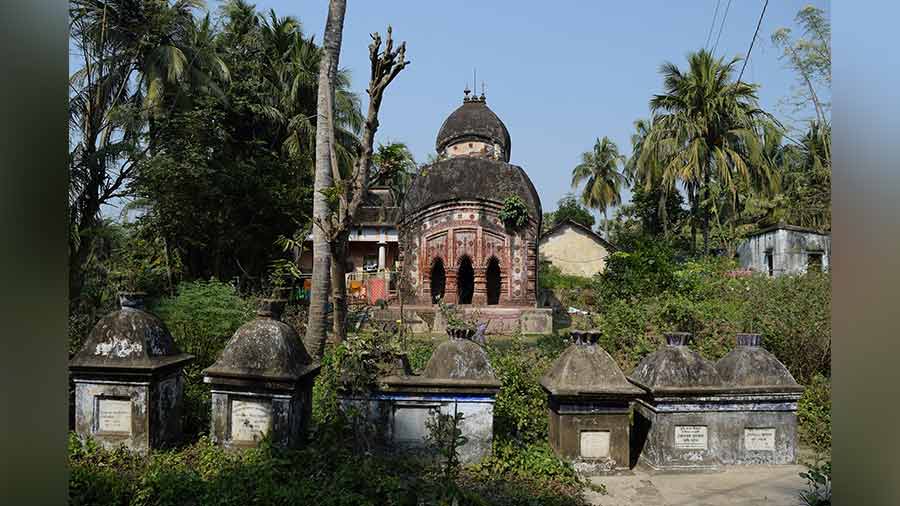
Shyamsundar temple at Jhikira
A 10-minute walk brings you to the neighbourhood of Madhyapara, which is lined by trees and mansions and has an old wooden bridge. On one side of the bridge is a nine-pinnacled temple, and on the other side, an aatchala temple said to be built in 1776. Both are called Damodar temples and belong to the Roys.
Further down a lane dotted with several memorial temples and dense bamboo trees are the last two prominent aatchala-style temples of Jhikira — the Sitanath temple of the Kanrar family, built in 1783, and the Damodar Jiu temple of the Mondal family, built in 1769.

The Sitanath temple of the Kanrar family at Jhikira
Both temples have a triple-arched entrance and terracotta motifs similar to the temples of Rautara. The foundation stone of the Damodar Jiu temples names a certain Sukdeb Mistri as the mason of the temple, leading one to wonder if he was the person who constructed many of the other temples in the area, which lends to the similarity in their designs.

The base panels of the Damodar Jiu temple of the Mondal family at Jhikira
A circular route covers the tours of Rautara and Jhikira, and takes about three hours. Take some time to visit the Jhikira Ramkrishna Vivekananda Society, close to the Mondal’s Damodar Jiu temple.
Amragari

Terrracotta panel at Dadhimadhab temple in Amragari
Only about a kilometre away from Jhikira, Amragiri is equally scenic. Of the various temples and old mansions, the one worth mentioning and visiting is the aatchala-style Dadhimadab temple built in 1764. A heritage structure, protected under the West Bengal State Archaeology Department, it has some rare terracotta panels, such as one depicting Hanuman carrying Gandhamadan mountain (in picture above ), and the vanar sena building Ram Setu.
Joypur (Jaypur)

Sridharjiu temple of the Das family in Joypur
Joypur is located midway between Amta railway station and Jhikira. The highlight of a tour here is another old aatchala-style temple, the Sridharjiu temple of the Das family, built in 1782. The design style and the terracotta motifs are similar to that of temples at Jhikira and Rautara.
In the nearby Jaleswar temple, an old stone Vishnu idol from the Pala dynasty era is worshipped as the presiding deity.
Travel details:
- Amta is about 50km/2hr from Kolkata by road. You can also take the train to Amta from Howrah, and then hire a car or a toto from the station to tour the villages. Driving from Kolkata, the villages can be comfortably seen in a day.
- Driving directions: Take the Kona Expressway towards Kolaghat. From Ranihati Bazaar crossing, drive straight towards Amta. At Amta railway station, turn left towards College More. Take right from the More, over the bridge crossing Damodar river to reach Narit bus stop. Take a right, Joypur is the first village on the route followed by Jhikira and Rautara.
- Where to eat: Except for some sweet and snacks shops, there are not many eateries in these villages. It is advisable to have your meals at restaurants and dhabas along the highway to and from Kolkata.
- Since these are not defined tourist spots, public utility facilities are limited or absent, except at a few petrol pumps between Ranihati Bazaar and Jhikira.
